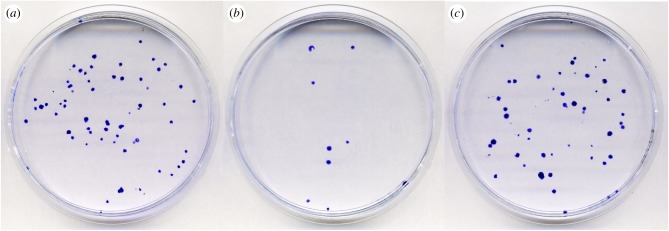Figure 3.
The Newbold–Amos experiment [26] reproduced to visualize the phenotypic suppression of recessive 6-thioguanine resistance (6-TGR) by the proximity of wild-type cells, and its prevention by the inflammatory agent, the tumour promoter TPA/PMA. Since 6-TG resistance is the phenotype of a loss-of-function mutation (Hprt enzyme deficiency), this figure displays symbolically a ‘disease in the Petri dish’ (by the number of growing blue Hprt−6-TGR mutant colonies) phenotypically suppressed by the excess of normal cells (compare (a,b)) and activated (promoted) by TPA/PMA (compare (b,c)). See the text and [26]. (a–c) plates were seeded each with 100 V79 Hprt−6-TGR cells. (b,c) received in addition 7.5 × 105 V79 Hprt+ 6-TGS cells. (c) contains also 1 ng ml−1 TPA/PMA. 6-TG and where appropriate TPA/PMA were added together 4 h after seeding and the cells fixed after 72 h incubation, then stained by crystal violet. (a–c) plates contain 68, 9 and 62 colonies, respectively. (b) shows 87% efficient phenotypic suppression that is nearly fully (91%) prevented by TPA/PMA in (c). The nine 6-TGR colonies in (b) grew presumably because of a delayed parabiotic contact with growing 6-TGS Hprt+ cells. (Courtesy of Sara Trifunovic and Mila Ljujic.)

